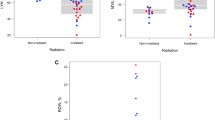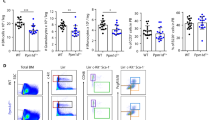Abstract
Cancer-causing genome instability is a major concern during space travel due to exposure of astronauts to potent sources of high-linear energy transfer (LET) ionizing radiation. Hematopoietic stem cells (HSCs) are particularly susceptible to genotoxic stress, and accumulation of damage can lead to HSC dysfunction and oncogenesis. Our group recently demonstrated that aging human HSCs accumulate microsatellite instability coincident with loss of MLH1, a DNA Mismatch Repair (MMR) protein, which could reasonably predispose to radiation-induced HSC malignancies. Therefore, in an effort to reduce risk uncertainty for cancer development during deep space travel, we employed an Mlh1+/− mouse model to study the effects high-LET 56Fe ion space-like radiation. Irradiated Mlh1+/− mice showed a significantly higher incidence of lymphomagenesis with 56Fe ions compared to γ-rays and unirradiated mice, and malignancy correlated with increased MSI in the tumors. In addition, whole-exome sequencing analysis revealed high SNVs and INDELs in lymphomas being driven by loss of Mlh1 and frequently mutated genes had a strong correlation with human leukemias. Therefore, the data suggest that age-related MMR deficiencies could lead to HSC malignancies after space radiation, and that countermeasure strategies will be required to adequately protect the astronaut population on the journey to Mars.
This is a preview of subscription content, access via your institution
Access options
Subscribe to this journal
Receive 12 print issues and online access
$259.00 per year
only $21.58 per issue
Buy this article
- Purchase on Springer Link
- Instant access to full article PDF
Prices may be subject to local taxes which are calculated during checkout






Similar content being viewed by others
References
Cucinotta FA, Schimmerling W, Wilson JW, Peterson LE, Badhwar GD, Saganti PB, et al. Space radiation cancer risks and uncertainties for Mars missions. Radiat Res. 2001;156(5 Pt 2):682–8.
Edwards AA. RBE of radiations in space and the implications for space travel. Phys Med: PM: Int J devoted the Appl Phys Med Biol: Off J Ital Assoc Biomed Phys. 2001;17(Suppl 1):147–52.
Schimmerling W, Cucinotta FA, Wilson JW. Radiation risk and human space exploration. Adv Space Res: Off J Comm Space Res. 2003;31:27–34.
Heinrich W, Roesler S, Schraube H. Physics of cosmic radiation fields. Radiat Prot Dosim. 1999;86:253–8.
Chancellor JC, Scott GB, Sutton JP. Space radiation: The number one risk to astronaut health beyond low earth orbit. Life. 2014;4:491–510.
V B. Health effects of exposure to low levels of ionizing radiation. 1990 20140718 ISBN- 0309039959 ISBN- 0309039975.
Bielefeldt-Ohmann H, Genik PC, Fallgren CM, Ullrich RL, Weil MM. Animal studies of charged particle-induced carcinogenesis. Health Phys. 2012;103:568–76.
Weil MM, Bedford JS, Bielefeldt-Ohmann H, Ray FA, Genik PC, Ehrhart EJ, et al. Incidence of acute myeloid leukemia and hepatocellular carcinoma in mice irradiated with 1 GeV/nucleon (56)Fe ions. Radiat Res. 2009;172:213–9.
Datta K, Suman S, Kallakury BV, Fornace AJ Jr.. Exposure to heavy ion radiation induces persistent oxidative stress in mouse intestine. PLoS One. 2012;7:e42224.
Wei K, Clark AB, Wong E, Kane MF, Mazur DJ, Parris T, et al. Inactivation of Exonuclease 1 in mice results in DNA mismatch repair defects, increased cancer susceptibility, and male and female sterility. Genes & Dev. 2003;17:603–14.
Iyer RR, Pluciennik A, Burdett V, Modrich PL. DNA mismatch repair: functions and mechanisms. Chem Rev. 2006;106:302–23.
Fritzell JA, Narayanan L, Baker SM, Bronner CE, Andrew SE, Prolla TA, et al. Role of DNA mismatch repair in the cytotoxicity of ionizing radiation. Cancer Res. 1997;57:5143–7.
Mazurek A, Berardini M, Fishel R. Activation of human MutS homologs by 8-oxo-guanine DNA damage. J Biol Chem. 2002;277:8260–6.
Macpherson P, Barone F, Maga G, Mazzei F, Karran P, Bignami M. 8-oxoguanine incorporation into DNA repeats in vitro and mismatch recognition by MutSalpha. Nucl Acids Res. 2005;33:5094–105.
Vilar E, Gruber SB. Microsatellite instability in colorectal cancer-the stable evidence. Nat Rev Clin Oncol. 2010;7:153–62.
Kinzler KW, Vogelstein B. Cancer-susceptibility genes. Gatekeepers and caretakers. Nature. 1997;386:761
Piao JS, Nakatsu Y, Ohno M, Taguchi K, Tsuzuki T. Mismatch repair deficient mice show susceptibility to oxidative stress-induced intestinal carcinogenesis. Int J Biol Sci. 2014;10:73–9.
Qing Y, Gerson SL. Mismatch repair deficient hematopoietic stem cells are preleukemic stem cells. PLoS One. 2017;12:e0182175.
Ma Y, Chen Y, Petersen I. Expression and promoter DNA methylation of MLH1 in colorectal cancer and lung cancer. Pathol Res Pract. 2017;213:333–8.
Gutierrez VF, Marcos CA, Llorente JL, Guervos MA, Iglesias FD, Tamargo LA, et al. Genetic profile of second primary tumors and recurrences in head and neck squamous cell carcinomas. Head & neck. 2012;34:830–9.
Stark AM, Doukas A, Hugo HH, Hedderich J, Hattermann K, Maximilian Mehdorn H, et al. Expression of DNA mismatch repair proteins MLH1, MSH2, and MSH6 in recurrent glioblastoma. Neurol Res. 2015;37:95–105.
Cosgrove CM, Cohn DE, Hampel H, Frankel WL, Jones D, McElroy JP, et al. Epigenetic silencing of MLH1 in endometrial cancers is associated with larger tumor volume, increased rate of lymph node positivity and reduced recurrence-free survival. Gynecol Oncol. 2017;146:588–95.
Kenyon J, Fu P, Lingas K, Thomas E, Saurastri A, Santos Guasch G, et al. Humans accumulate microsatellite instability with acquired loss of MLH1 protein in hematopoietic stem and progenitor cells as a function of age. Blood. 2012;120:3229–36.
Kenyon J, Nickel-Meester G, Qing Y, Santos-Guasch G, Drake E, Pingfu Fu, et al. Epigenetic Loss of MLH1 Expression in Normal Human Hematopoietic Stem Cell Clones is Defined by the Promoter CpG Methylation Pattern Observed by High-Throughput Methylation Specific Sequencing. Int J Stem Cell Res Therapy. 2016;3:031.
Edelmann W, Cohen PE, Kane M, Lau K, Morrow B, Bennett S, et al. Meiotic pachytene arrest in MLH1-deficient mice. Cell. 1996;85:1125–34.
Bacher JW, Abdel Megid WM, Kent-First MG, Halberg RB. Use of mononucleotide repeat markers for detection of microsatellite instability in mouse tumors. Mol Carcinog. 2005;44:285–92.
Bolger AM, Lohse M, Usadel B. Trimmomatic: a flexible trimmer for Illumina sequence data. Bioinformatics. 2014;30:2114–20.
Li H, Durbin R. Fast and accurate short read alignment with Burrows-Wheeler transform. Bioinformatics. 2009;25:1754–60.
DePristo MA, Banks E, Poplin R, Garimella KV, Maguire JR, Hartl C, et al. A framework for variation discovery and genotyping using next-generation DNA sequencing data. Nat Genet. 2011;43:491.
Cibulskis K, Lawrence MS, Carter SL, Sivachenko A, Jaffe D, Sougnez C, et al. Sensitive detection of somatic point mutations in impure and heterogeneous cancer samples. Nat Biotechnol. 2013;31:213–9.
Obenchain V, Lawrence M, Carey V, Gogarten S, Shannon P, Morgan M. VariantAnnotation: a Bioconductor package for exploration and annotation of genetic variants. Bioinformatics. 2014;30:2076–8.
Tokairin Y, Kakinuma S, Arai M, Nishimura M, Okamoto M, Ito E, et al. Accelerated growth of intestinal tumours after radiation exposure in Mlh1-knockout mice: evaluation of the late effect of radiation on a mouse model of HNPCC. Int J Exp Pathol. 2006;87:89–99.
Edelmann W, Yang K, Kuraguchi M, Heyer J, Lia M, Kneitz B, et al. Tumorigenesis in Mlh1 and Mlh1/Apc1638N mutant mice. Cancer Res. 1999;59:1301–7.
Yao X, Buermeyer AB, Narayanan L, Tran D, Baker SM, Prolla TA, et al. Different mutator phenotypes in Mlh1- versus Pms2-deficient mice. Proc Natl Acad Sci USA. 1999;96:6850–5.
Scott DW, Gascoyne RD. The tumour microenvironment in B cell lymphomas. Nat Rev Cancer. 2014;14:517–34.
Hause RJ, Pritchard CC, Shendure J, Salipante SJ. Classification and characterization of microsatellite instability across 18 cancer types. Nat Med. 2016;22:1342–50.
Fan X, Li Y, Zhang Y, Sang M, Cai J, Li Q, et al. High Mutation Levels are Compatible with Normal Embryonic Development in Mlh1-Deficient Mice. Radiat Res. 2016;186:377–84.
He D, Chen Y, Li H, Furuya M, Ikehata H, Uehara Y, et al. Role of the Msh2 gene in genome maintenance and development in mouse fetuses. Mutat Res. 2012;734:50–5.
Dovat S, Song C, Payne KJ, Li Z. Ikaros, CK2 kinase, and the road to leukemia. Mol Cell Biochem. 2011;356:201–7.
Payne KJ, Dovat S. Ikaros and tumor suppression in acute lymphoblastic leukemia. Crit Rev Oncog. 2011;16:3–12.
Gutierrez A, Kentsis A, Sanda T, Holmfeldt L, Chen SC, Zhang J, et al. The BCL11B tumor suppressor is mutated across the major molecular subtypes of T-cell acute lymphoblastic leukemia. Blood. 2011;118:4169–73.
Lopez-Nieva P, Vaquero C, Fernandez-Navarro P, Gonzalez-Sanchez L, Villa-Morales M, Santos J, et al. EPHA7, a new target gene for 6q deletion in T-cell lymphoblastic lymphomas. Carcinogenesis. 2012;33:452–8.
Cucinotta FA, Nikjoo H, Goodhead DT. Model for radial dependence of frequency distributions for energy imparted in nanometer volumes from HZE particles. Radiat Res. 2000;153:459–68.
Mirsch J, Tommasino F, Frohns A, Conrad S, Durante M, Scholz M, et al. Direct measurement of the 3-dimensional DNA lesion distribution induced by energetic charged particles in a mouse model tissue. Proc Natl Acad Sci USA. 2015;112:12396–401.
Weil MM, Ray FA, Genik PC, Yu Y, McCarthy M, Fallgren CM, et al. Effects of 28Si ions, 56Fe ions, and protons on the induction of murine acute myeloid leukemia and hepatocellular carcinoma. PLoS ONE. 2014;9:e104819.
Suman S, Kumar S, Moon BH, Strawn SJ, Thakor H, Fan Z, et al. Relative Biological Effectiveness of Energetic Heavy Ions for Intestinal Tumorigenesis Shows Male Preponderance and Radiation Type and Energy Dependence in APC(1638N/ + ) Mice. Int J Radiat Oncol Biol Phys. 2016;95:131–8.
Wang X, Farris Iii AB, Wang P, Zhang X, Wang H, Wang Y. Relative effectiveness at 1 gy after acute and fractionated exposures of heavy ions with different linear energy transfer for lung tumorigenesis. Radiat Res. 2015;183:233–9.
Rithidech KN, Honikel LM, Reungpathanaphong P, Tungjai M, Jangiam W, Whorton EB. Late-occurring chromosome aberrations and global DNA methylation in hematopoietic stem/progenitor cells of CBA/CaJ mice exposed to silicon ((28)Si) ions. Mutat Res. 2015;781:22–31.
Kennedy EM, Powell DR, Li Z, Bell JSK, Barwick BG, Feng H, et al. Galactic Cosmic Radiation Induces Persistent Epigenome Alterations Relevant to HumanLung Cancer. Sci Rep. 2018;8:6709.
Sridharan DM, Asaithamby A, Bailey SM, Costes SV, Doetsch PW, Dynan WS, et al. Understanding cancer development processes after HZE-particle exposure: roles of ROS, DNA damage repair and inflammation. Radiat Res. 2015;183:1–26.
Chang J, Luo Y, Wang Y, Pathak R, Sridharan V, Jones T, et al. Low doses of oxygen ion irradiation cause acute damage to hematopoietic cells in mice. PLoS ONE. 2016;11:e0158097.
Eccleston J, Yan C, Yuan K, Alt FW, Selsing E. Mismatch repair proteins MSH2, MLH1, and EXO1 are important for class-switch recombination events occurring in B cells that lack nonhomologous end joining. J Immunol. 2011;186:2336–43.
Chahwan R, van Oers JM, Avdievich E, Zhao C, Edelmann W, Scharff MD, et al. The ATPase activity of MLH1 is required to orchestrate DNA double-strand breaks and end processing during class switch recombination. J Exp Med. 2012;209:671–8.
Gutmann DH, Winkeler E, Kabbarah O, Hedrick N, Dudley S, Goodfellow PJ, et al. Mlh1 deficiency accelerates myeloid leukemogenesis in neurofibromatosis 1 (Nf1) heterozygous mice. Oncogene. 2003;22:4581–5.
Fang Y, Tsao CC, Goodman BK, Furumai R, Tirado CA, Abraham RT, et al. ATR functions as a gene dosage-dependent tumor suppressor on a mismatch repair-deficient background. EMBO J. 2004;23:3164–74.
Rodman C, Almeida-Porada G, George SK, Moon J, Soker S, Pardee T, et al. In vitro and in vivo assessment of direct effects of simulated solar and galactic cosmic radiation on human hematopoietic stem/progenitor cells. Leukemia. 2017;31:1398–407.
Acknowledgements
This research was funded by NASA grant NNX14AC95G. We are grateful to all members of NASA Space Radiation Laboratory and support staff at Brookhaven National Laboratory, in particular to Adam Rusek, Chiara La Tessa, and Peter Guida, for their assistance. We are also thankful to shared resources of the Case Comprehensive Cancer Center including Radiation Resources, Integrated Genomics, Cytometry & Microscopy, and Hematopoietic Biorepository & Cellular Therapy. We also thank the generosity of Thomas F. Peterson, Jr.
Funding
This research was funded by NASA grant NNX14AC95G.
Author information
Authors and Affiliations
Corresponding author
Ethics declarations
Conflict of interest
The authors declare that they have no conflict of interest.
Electronic supplementary material
Rights and permissions
About this article
Cite this article
Patel, R., Zhang, L., Desai, A. et al. Mlh1 deficiency increases the risk of hematopoietic malignancy after simulated space radiation exposure. Leukemia 33, 1135–1147 (2019). https://doi.org/10.1038/s41375-018-0269-8
Received:
Revised:
Accepted:
Published:
Issue Date:
DOI: https://doi.org/10.1038/s41375-018-0269-8



